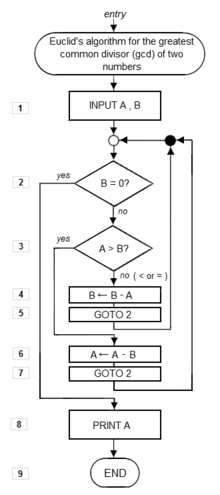In mathematics and computer science, an algorithm  i/ˈælɡərɪðəm/ (originating from al-Khwārizmī, the famous Persian mathematician Muḥammad ibn Mūsā al-Khwārizmī) is a step-by-step procedure for calculations. Algorithms are used for calculation, data processing, and automated reasoning.
i/ˈælɡərɪðəm/ (originating from al-Khwārizmī, the famous Persian mathematician Muḥammad ibn Mūsā al-Khwārizmī) is a step-by-step procedure for calculations. Algorithms are used for calculation, data processing, and automated reasoning.
More precisely, an algorithm is an effective method expressed as a finite list[1] of well-defined instructions[2] for calculating a function.[3] Starting from an initial state and initial input (perhaps empty),[4] the instructions describe a computation that, when executed, will proceed through a finite [5] number of well-defined successive states, eventually producing "output"[6] and terminating at a final ending state. The transition from one state to the next is not necessarily deterministic; some algorithms, known as randomized algorithms, incorporate random input.[7]
A partial formalization of the concept began with attempts to solve the Entscheidungsproblem (the "decision problem") posed by David Hilbert in 1928. Subsequent formalizations were framed as attempts to define "effective calculability"[8] or "effective method";[9] those formalizations included the Gödel–Herbrand–Kleene recursive functions of 1930, 1934 and 1935, Alonzo Church's lambda calculus of 1936, Emil Post's "Formulation 1" of 1936, and Alan Turing's Turing machines
of 1936–7 and 1939. Giving a formal definition of algorithms,
corresponding to the intuitive notion, remains a challenging problem.[10]
Flow chart of an algorithm (Euclid's algorithm) for calculating the greatest common divisor (g.c.d.) of two numbers a and b
in locations named A and B. The algorithm proceeds by successive
subtractions in two loops: IF the test B ≥ A yields "yes" (or true)
(more accurately the number b in location B is less than or equal to the number a in location A) THEN the algorithm specifies B ← B − A (meaning the number b − a replaces the old b).
Similarly IF A > B THEN A ← A − B. The process terminates when (the
contents of) B is 0, yielding the g.c.d. in A. (Algorithm derived from
Scott 2009:13; symbols and drawing style from Tausworthe 1977).

No comments:
Post a Comment